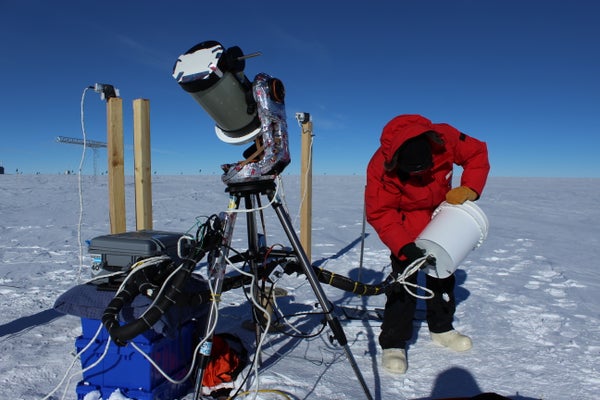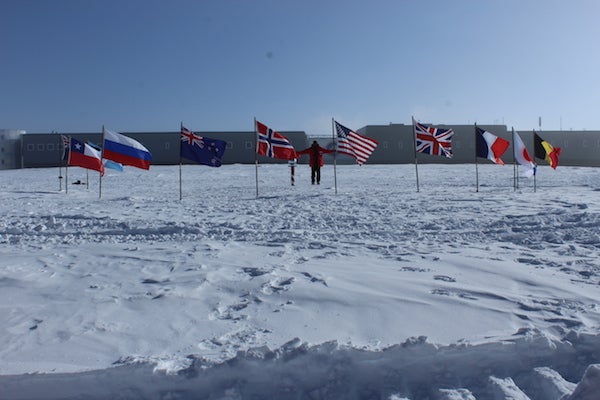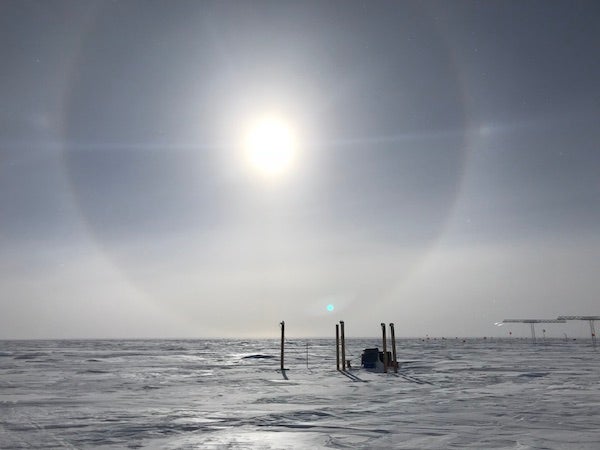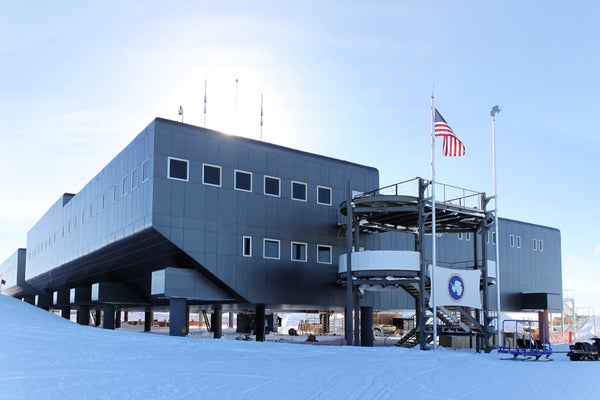This article was published in Scientific American’s former blog network and reflects the views of the author, not necessarily those of Scientific American
Author’s note: Names have been changed to protect the identities of current Antarctic Program participants.
Flying south from McMurdo, crossing the Transantarctic Mountains yields hundreds of miles of flat plateau and icy emptiness. Thick rivers of endlessly blowing snow eddy and stream beneath the wings. The landscape looks and feels like an alien world. Suddenly there’s a tiny speck in the distance, so small it could very well be dirt on the window. Minutes later, it resolves into an elevated building on stilts, surrounded by absolutely nothing to distinguish it from the wilderness around it. A human presence so far from civilization, that the world and all its cares might as well be a planet away. The first time you come to Antarctica, they say, is for the adventure.
The second time is for the money.
On supporting science journalism
If you're enjoying this article, consider supporting our award-winning journalism by subscribing. By purchasing a subscription you are helping to ensure the future of impactful stories about the discoveries and ideas shaping our world today.
The third time is because now you don’t fit anywhere else.
We’re seated along the sides of a military LC-130 aircraft, separated from the other end of the airplane by tall pallets of cargo marked “Do Not Freeze.” The temperature inside has been dropping steadily for the last half an hour as we make our approach to Amundsen-Scott Research Station, just feet from the South Pole, and we’re all huddled in our bright red cold-weather gear.
Looking around, it’s easy to tell who has been here before and who hasn’t. I’m a fyngie, a first-timer to “the ice,” and I fidget in my seat, listening eagerly for the bump under my feet that will signify that I have landed at the bottom of the world. Beside me a lanky New Zealander stirs inside his jacket, loosely draped around his shoulders, then continues sleeping. He won’t rouse himself until the plane has stopped taxiing, and the cargo door in the back begins to drop. He’s what they call an OAE, or “Old Antarctic Explorer.”
To him, this is the start of just another season.
Almost every American’s first stop on Antarctica is Mactown, formally McMurdo; the largest station on the ice continent, with the look and feel of an Alaskan mining town, right down to the special deputy U.S. marshal with the moustache to match an old Western. Eight hours before disembarking the LC-130 at the bottom of the world, Cindy L. was our bus driver from Mactown out to Willy Airfield, where the ski planes landed. “I haven't been able to get to the Pole yet, but I really want to go!” Cindy said when she heard my destination. “But just to see it.... I don’t know if I have the personality to be a Polie.”
The average workday at Amundsen-Scott South Pole Research Station—just Pole to the residents—is 12 hours a day, seven days a week. The kitchen staff makes four meals a day, every day. Pole revolves around the services of cargo planes; regardless of when they arrive, they must be unloaded within a matter of hours so the plane can get back to warmer climates. Relentless, punishing work is the only way to keep this small foothold at the bottom of the world functioning. The mission never stops, even when there’s a blizzard outside. And yet, people keep coming back. As planes land early in the season, OAEs greet one another familiarly, and old hands welcome new teammates into the fold. There’s continuity to the place, an implicit knowledge that everyone must pitch in and do their part.
Philip X. doesn’t do dishes. At home, he lets them pile up in the sink; “until my wife yells at me that there are no more plates left, and then I suppose it’s time.” It’s his third season at Pole, and during the kitchen staff’s break, he’ll slip into the galley and attack the dish pit with a fervor, cleaning as many as a hundred plates to give the cooks a dent in their afternoon workload. I don’t understand, I tell him. Your wife would love this treatment.
“We have the luxury of the water and power to run a dishwasher at home,” he says. “Dirty dishes aren’t that big a deal, not really. If I do the dishes here when I have a free moment, that means time back in someone’s day. Somebody will put time back in my day. It makes an easier time for all of us.”
In his book about his time as an astronaut, Clayton Anderson mentions something called “good expeditionary behavior.” It’s a mentality that NASA tries to instill in its astronauts, to help out when you don’t have to, just to make things easier on the group as a whole. It seems to me that this mentality is somehow instilled, without any formal training, into everyone that comes back here. Those who are new must learn quickly. Some don’t adapt, however ... and they choose not to come back.
The people who return are the ones like Darrell L., who applied seven times to be part of the U.S. Antarctic Program before being picked this year. Darrell has a decade of experience for major defense contractors and NASA under his belt, but he ends up assigned to spend a week with me in the cold, digging random holes in the snow, trying to find a power vault from a decade ago. His enthusiasm isn't damped. Almost everyone here, even the cooks and fuelies, have advanced degrees. A few years ago, the janitor had a PhD. These people could be successful doing anything else, for less misery and more pay. They are choosing to be here.
“I’ve learned so much about myself from eight seasons,” Timothy K., the breakfast cook, tells me. “Antarctica helps you figure out what’s really important, because so much isn’t. Here, you just learn how to do without.”
And that’s when it hits me. Ever since I’ve landed at Pole, I’ve felt like something was missing, and now I realize what it is. No one has a cell phone in their hand.
People eat alone at the dining cafeteria, but they aren’t on their smartphones, pretending to be busy. People walk the hallways, but no one’s head is bent away from eye contact with the world around them. There is no Wi-Fi at the bottom of the planet. At about 10 P.M. local time, an old military satellite comes overhead, and gives you about six hours of connection to the world, but bandwidth is limited. Facebook barely loads; Instagram is impossible. Early in the morning, you might get another hour or two from the NASA TDRS satellites, but after 9 A.M., Antarctica is disconnected from the world, focused on the challenges of the day.
I realize that the time I spend on the internet checking email, posting humble-brags on social media, and agonizing over the news, has dropped drastically. I watch the TVs around the station to see when there are planes landing, because that’s what life revolves around. I take my turn being the “house mouse” and cleaning the bathroom, because the janitor has enough to do. I follow the prohibition of two-minute showers no more than twice a week, because while ice is all around, it takes precious fuel flown in by airplane to melt it into water. When I forget what the world smells like, I spend an hour in a room filled with hydroponic plants, drinking in the humidity and earthy smells. After a while, there just isn't a world except for this strange and co-dependent one.
“It’s a harsh continent,” the station manager likes to say, and the “screaming barfies” are my first indication of that.
It happens after being outside all day, in summer wind chill of 68 below zero Fahrenheit. I’ve been trying to assemble a telescope to measure atmospheric turbulence at the South Pole, an assembly that requires often removing my bulky outer gloves to push buttons on the telescope’s controller. I have a heat gun in my other hand, constantly firing a 400 degree F stream of warmth at my whitened knuckles, and I don’t feel anything, not even the metal under my fingertips.

At work on the ice, assembling the only optical telescope at Pole. The lesson of gloves at all times was quickly learned. Credit: Michael Nayak
When I go back indoors, my fingers feel like four stiff blocks of ice, and I can’t flex them. A tingling starts, then quickly grows into a furious fire that keeps me up through the night, nauseous and a little faint. I muffle a scream as my hand starts to pulse. The circulation has been altered at 60 below. It’ll take a few painful days to restore itself, and the body tries to throw up as a survival response to the sudden and furious amount of pain it’s in. Hence: the “screaming barfies.”
A week later, I get my first package in the APO mailbox at South Pole Station, and I’m surprised by how hard it hits me. It’s just socks and chocolate from a friend, but I stare at the Post-it note on the socks (“Dobby is a free elf!”), lost in thought for several minutes. I’ve only been away from home for a month and a half now. But as you look out of the window, at blowing snow streaming away to the edge of the horizon, and realize that there’s nothing past that... it can feel like a lot longer.
It’s a harsh continent in more than one way.
Steve B. is perhaps the ultimate OAE. He asks me not to list the exact number of seasons he has “wintered over,” because it makes him easy to be identified, but it’s over half a dozen. He will increase that tally by one this year. When the last military plane leaves South Pole in late February, he will not see another new face for eight months.
This suits him just fine, he tells me. “The summer stresses me out,” he says. “There’s a lot happening, a lot of new faces. When the winter sets in, you can get down to the business of living, because now the variables are set, and you can start figuring them out.”
The variables are the 40-odd other people who will winter-over with him. Together, they will endure six months of darkness, cold below negative 100 degrees F, nothing but frozen food, and an isolation that can’t be matched anywhere on the planet. Astronauts have it easy by comparison, the “Polies” like to joke. If they get in trouble, they can jump in their Soyuz capsule, hit a button and be back in civilization less than 12 hours later.
It’s not quite as easy to escape from the Pole. 2015 was the first time a medical evacuation occurred in the dead of winter, a logistical operation previously considered impossible. The isolation is long, and the darkness plays tricks on the mind. Moods are like a cold; contagious, and they must work their way through everyone before they can die away. The winter-overs are tight crews, guarded with details to those who haven’t experienced a winter themselves, but OAEs joke about “Angry August,” when the mood of the station turns dark and irate. Nothing can please you; everything is frustrating; you’re positive you will lose your mind before that first summer plane arrives in October. The stage passes, Steve says ... mostly.
But what about you, I ask Steve. Several winters under your belt, and you keep coming back. Surely you must have found a way around it.
He shakes his head. “It really depends on the crew, and station management,” he says. “Some years, I hardly feel Angry August. Other years, it comes early and lasts longer, because things are not going well among the group. Even after all these years ... I know my state of mind toward the end of winter will depend on the people around me.”
Some years, August passes very pleasantly. So pleasantly that Polie veterans start to worry about a Stabby September. It’s something of a joke ... but the stakes are real. This past year, a Russian winter-over at Bellingshausen research station stabbed his colleague for telling him the ending to books he was reading. His only escape from the isolation had been ruined. It was the ultimate “gone toasty,” an expression Polies use to describe being burnt out toward the end of the winter.
Then what keeps you coming back, I have to ask Steve. Is it the science?
Steve responds without hesitation. “It’s the people,” he says.
Twenty years of Antarctic experience has taught him that there are no two- or three-time Antarctic voyagers. It’s either just once and never again, or “as many times as possible.” I’ve already learned that I’m in the latter group. I’m hungry to winter-over. It sounds terrible, and fascinating, at the same time. And even though I’m only a summer resident, seemingly evanescent to those who have spent decades here, I can see that it is, in fact, the people. The work is satisfying, but science moves on with or without you. It’s the people you meet, and the bonds you make. It’s why you don’t fit anywhere else after your second season, and feel the need to return to the camaraderie and shared hardship of Antarctica.

The author at the Ceremonial South Pole. Credit: Michael Nayak
There’s a picture of me grinning at the Ceremonial South Pole, where visitors can have their photos taken without making the effort to walk to the actual, geographic South Pole, whose location in relation to the station changes as the ice moves. It cost $58,000 to get there: charges vary slightly by company, but that is approximately the price tag to fly down to 90 degrees south. Spending just one night at “summer camp,” a small groomed area north of the Ceremonial South Pole, can cost a hundred thousand dollars.
Residents at Amundsen-Scott Research Station are either a “grantee” like me, with scientific approval and funding from the NSF, or “support,” enabling that science with fuel, food and cargo. By definition, being accepted as a U.S. Antarctic Program principal investigator means your research cannot be accomplished better anywhere else on the planet.
The six-month darkness at the South Pole, for example, allows me to improve frequency resolution on Jupiter by 10 times, revealing new information on how our solar system evolved. Radio astronomers working to probe the earliest moments of the Big Bang rely on the pristine atmosphere to see deeper into the universe than the Hubble Space Telescope ever could. The cleanest air in the world blows through the Pole, untainted by human activity, presenting an unbeatable baseline for climate change monitoring.
But research that requires high-profile military, diplomatic and logistical cooperation often makes for an inviting target. Jealously selective as this citadel of pure science is, if its exploits don’t play well in 30-second soundbites, it can find itself directly in the crosshairs.
In 2011, Republican Senator Tom Coburn released a report called The National Science Foundation: Under the Microscope, part of a long crusade against the agency. One of the catchiest headlines that emerged was: ‘Tax dollars fund shrimp on treadmills.’ There was a price tag ($3 million) and a viral video to go with the headline (sure enough, a shrimp on a tiny treadmill). The full story was far less catchy. The $3 million came over a decade, to study how changes to ocean chemistry by human activity could affect the ability of marine life to fight infections. The treadmill charted the immune response of shrimp when they were physically stressed. The more stressed the shrimp are, the fewer bacteria they purge from their body, and therefore, the more bacteria that would be ingested by seafood consumers. The treadmill cost $47, paid by the principal investigator out of his own pocket.
But this thoughtful response didn’t play on national television as well as Sen. Coburn’s well-packaged soundbite: “Three million for a shrimp treadmill. What the heck are these scientists doing?”
Much as the environment might hint otherwise, the South Pole is not divorced from mothership USA. By treaty, the U.S. presence on Antarctica exists for one reason: scientific research. In a political environment charged against factual science about our planet, the government’s presence and continued investment in Antarctica is a delicate matter. It’s for this reason that all the names in this article have been changed, and descriptive details about these unique Antarctic voyagers left out.

The author's experiment site, half a mile south of the Station. Credit: Michael Nayak
No one here wants to endanger the program, or their presence within it, with an ill-chosen word. People with me at the station would not speak on record for fear of backlash from the NSF, but it’s well understood that they are not the enemy. The NSF is forced to react to protect the larger prize; trim a branch to save the tree.
It’s a harsh continent in more than one way.
When science is dangerously close to a curse word, everyone must hold their breath and tread softly. Antarctic scientists must not just work against the odds and the weather, but also against careless presentation of their science to the public. Their life’s work must be handled as if it’s toxic, because it can be.
“This is the last good gig that the good gig police haven't found about,” Major Aberdeen L. tells me on the C-17 flight from New Zealand to Antarctica. He was selected for the next rank, but transferred to the Air Force Reserve so he would not be promoted away from visiting the ice. “But wait until they do. This place will change. And that kind of change is rarely for the better.”
My room looks out on the South Pole, and in the distance is the tourist summer camp. By location, the small room I occupy is probably the most expensive room I’ve ever stayed in, but I won’t receive a bill. Surely, I think, we could fund so much more science by leasing a wing of the station to visitors. Everyone would benefit; both the tourists that spend tens of thousands to be here, and the scientists that need this unique environment to learn about the universe around us.
But such things have a way of making their way to people searching for the next shrimp-on- a-treadmill story, and no one, especially me, wants this place to change. For now, this bastion of pure science still stands, alone on a desolate snowy desert plateau... the last good gig.
